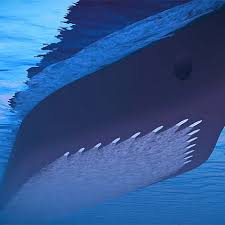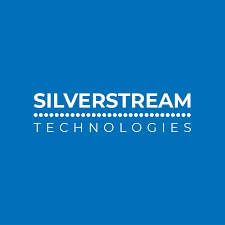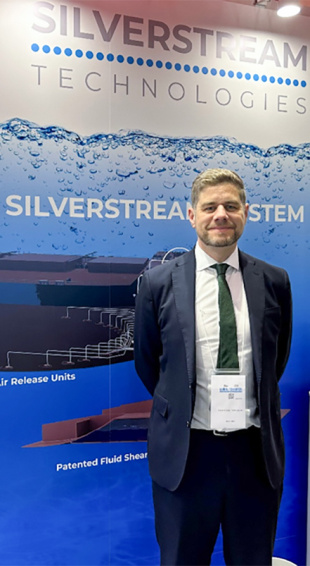〆Major industry players, including BP, Shell, Chevron, Klaveness, Carnival, and Grimaldi, have adopted this system for both new and existing ships.
〆The company is also expanding its market presence in Japan.
(Introduction)
Based in the UK, Silverstream Technologies has developed and scaled an innovative air lubrication technology – The Silverstream® System. This technology changes the interaction between the water and the vessel. It shears air from air release units (ARUs) in the hull to create a uniform carpet of microbubbles that coats the full flat bottom of a vessel, reducing frictional resistance. The Silverstream® System can contribute to greener shipping necessary to meet the International Maritime Organization’s (IMO) goal of net-zero greenhouse gas (GHG) emissions by 2050. Major oil companies such as BP and Shell, along with leading dry bulk operator Klaveness and cruise giant Carnival, have already adopted Silverstream’s technology. It can be installed on new builds as well as retrofitted onto existing vessels. During his visit to Japan for Sea Japan, I spoke with Mr. Daniel Mann, VP of Business Development at Silverstream Technologies, about their unique technology.
(Interviewer: Hirofumi Yamamoto)

1)JMD:What is the story behind the founding of Silverstream?
Mann: “Silverstream was founded by Noah Silberschmidt (CEO and Founder) who is from Denmark, a great historic shipping nation. Growing up with a passion for the sea, he spent a lot of time on the water from an early age and had a keen interest in maritime vessels. Competing in regattas gave Noah a good understanding of the impact of wind and weather on sailing. He saw an opportunity to not only aid the maritime market and its stakeholders but also to contribute to the reduction of greenhouse gas emissions. Decarbonization is a challenge that affects ships, maritime stakeholders, and the industry as a whole, and the annual cost of fuel is substantial. At the time, the necessity and benefits of such innovations were not as widely recognized as they are today.”
2)JMD: What is the principle of AIR LUBRICATION”?
Mann:”Air lubrication technology harnesses the power of both the air and our oceans. The Silverstream® System utilizes a natural phenomenon known as Kelvin-Helmholtz instability. This involves the interaction of two fluids. In essence, air is introduced into cavities located at the ship’s bottom, where it is then sheared as it emerges. Water flows underneath this layer of air. This shearing creates a uniform carpet of microbubbles that coats the full flat bottom of a vessel and significantly reduces the friction of the ship moving through water.
3)JMD: How does air lubrication actually foam the hull? What are the technical aspects of this process?
Mann:”In practice, air lubrication systems do not all operate in the same manner. Unlike our competitors’ technologies, our patented Silverstream® System shears air from air release units in the hull to operate. This process occurs within the air release units, where water and air interact to create a dense carpet of fine, uniform microbubbles that cover the entire flat bottom of the ship.”
“The advantage of our system lies in the high density of these low-energy microbubbles that do not fuse or aggregate. They require minimal energy to produce, yet effectively remain within the boundary layer to reduce frictional resistance. This is the cutting-edge aspect of our technology.”
“Our system functions by installing 8-20 ARUs along the flat bottom inside the double hull of the ship. Each unit is approximately 4 meters in length and plays a crucial role in the physical dynamics behind the efficiency of the Silverstream® System.”
“From an engineering perspective, the Silverstream® System can be easily integrated into the design of new vessels and is also capable of being retrofitted onto existing ships. Retrofits are typically completed within six to nine months of the order and can typically be installed within 10 days during planned dry-docking operations, with the fastest recorded to date being 6 days. We can also install elements of the system with a travelling crew while the vessel is in operation, ensuring minimal disruption to regular shipping activities.”

4)JMD:Silverstream Technologies offers air lubrication technology that reduces environmental and operational impact on all types of vessels. How effective can this system be?
Mann “Air lubrication systems harness fluid dynamics to achieve reductions in fuel consumption and emissions for ships. Our proven technology, the Silverstream® System, reduces average net fuel consumption and greenhouse gas (GHG) emissions by 5-10%. Our system is applicable across all maritime segments and is effective under all sea conditions, regardless of the type of fuel used. The Silverstream® System has also been independently verified by Lloyd’s Register, HSVA, the University of Southampton, Carnival, Shell and others. “
“The commercialization and scaling of air lubrication technology are instrumental in addressing fundamental challenges in current ship efficiency, contributing to cleaner and greener ships needed to meet the International Maritime Organization’s (IMO) revised net-zero greenhouse gas (GHG) emissions targets by 2050.”
“Our system not only provides fuel savings and emission reductions today but also serves as a lifetime efficiency solution for vessels. Unlike many other technologies available in the market, our system is suitable for both retrofit installations and new builds, safeguarding ships from future cost increases and regulations as environmental targets continue to become more stringent.”

5)JMD – From January 2024, the EU ETS will be implemented for ships within Europe. How can the Silverstream® System help shipping companies reduce emissions?
Mann: “The European Union’s Emissions Trading System (EU ETS) represents a significant regulation and potential additional cost for shipping companies operating voyages to the EU. It is reported that Asian carriers may be among the hardest hit due to the length of their voyages to and from the EU. Under this new regulation, owners will have to purchase and use EU emissions allowances. The system covers 50% of emissions on voyages to and from the EU, and 100% of emissions during European transits and port calls.”
“Regardless of the focus of environmental regulations, the direction forward is clear, and our system can lower the cost of regulatory compliance, reduce fuel expenses, and help shipping companies strive towards their environmental goals.”

6) What are some of the companies, organizations, or associations that have implemented Silverstream Technologies’ solutions?
Mann: “We currently have 73 systems in operation, demonstrating reliable performance. Out of the current orders, 37 are for LNG carriers, with 15 systems already operational on such vessels. Silverstream’s clientele includes major industry players such as BP, Shell, Chevron, Klaveness, Carnival, and Grimaldi, many of whom are repeat customers due to the system’s reliability and performance.”
“Many clients have committed to fleet-wide contracts. In 2021, MSC secured the largest order for marine propulsion clean technology to install systems on over 30 of their container ships. This agreement is estimated to reduce around 1.6 million tonnes of CO2 emissions and save over 250 million euros in fuel costs over the life of the equipment. MSC has ordered a total of 84 systems from Silverstream.”
“We also have agreements with 22 shipyard partners to ensure smooth installation and technical support. In Asia, this includes major shipyards like Jiangnan Shipyard, China Merchants Heavy Industries, China Shipbuilding Industry Corporation (CSSC), China Merchants Group, Malaysia Marine and Heavy Engineering (MHB), Dubai Drydocks, and Seatrium. Additionally, we have an Approval in Principle Agreement (AIP) with the China Classification Society, and our presence in Asia is bolstered by our Shanghai office.”

7) JMD-What are Silverstream Technologies’ expectations for the Japanese market in the future? And what strategies do you plan to use to reach potential customers in Japan?
Mann:“We are encouraged by the ongoing conversations with the Japanese maritime community and see strong opportunities in this key global shipping nation. We recognize that Japanese ship owners are investing in LNG carriers and already possess robust fleets of bulk carriers, oil tankers, and container ships. All these vessels could benefit significantly from efficiency improvements using our system.”
“Our supply chain is supported by major local partners, ensuring resilience and high-quality service. Last year, we signed an agency agreement with Orient Marine Co., Ltd., a subsidiary of Mitsui & Co., for sales and strategic support in Japan. Having Orient Marine as an ally as we continue to build relationships in Japan is invaluable. Face-to-face meetings with key players in the maritime industry in Japan play a central role in continuing our growth strategy.”

■Profile
Daniel Mann
Mr. Mann has over 25 years’ experience in maritime, power generation and oil and gas industries with Rolls-Royce, MAN Diesel & Turbo, Dresser-Rand, Siemens and, most recently, Ethos Energy where he was the Global Sales Director for its light gas turbine business.
Throughout his career, he has held senior roles in sales, service, business development and business management and brings vast experience in ship equipment retrofit projects and servicing.
Daniel holds an MSc in Project Management from the University of Manchester, and an MBA from Manchester Business School.
